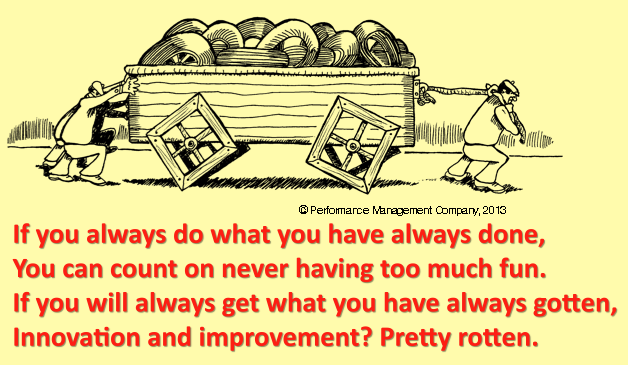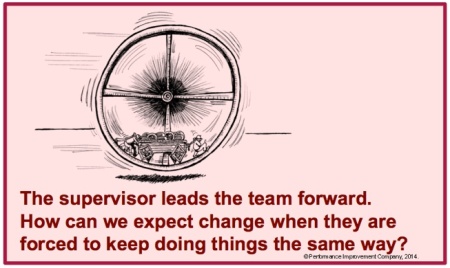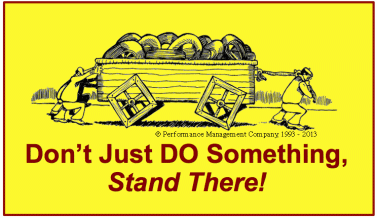Check me on this if you can, but we keep talking about improving workplace performance by the active involvement and engagement of people doing their jobs. There are lots of reasons as well as lots of data that support this as a REALLY good idea because of the widespread impacts on results.
Just back from ASTD and after conversations with colleagues, both there as well as in a variety of email connections, it seems that this engagement idea is a non-starter and doomed for failure in so many organizations. In a simple illustration, let me anchor down my thoughts:
Does anyone really think that HR is going to be able to do some kind of training event or lead some kind of organizational improvement initiative to involve and engage all the workers? Maybe, and I can think of a couple of organizations that have the culture to pull that off. But the day-to-day reality of the supervisory environment would suggest that improvement generated by active involvement and participation is a high-risk activity for most supervisors in most organizations.
After all, are they not already busy right now? Are they not up to their eyeballs in tasks and reports and meetings and reports and tasks? Do we simply expect that they would be motivated to do some “public speaking” and set up meetings where they involve people to share ideas about workplace issues and problems (and then expect some resolution and improvement) or is it a lot safer just to continue to do things the same way.
What is the Reality of this (from their perspective)?
Lee Ellis popped up a nice blog post here that I summarize:
Three strong indicators of an unhealthy organization are:
• A lack of trust leading to poor teamwork and alignment.
• A lack of clarity about mission, vision, and values.
• A fear of conflict. People are not allowed to say what they really think.
A healthy organization, alternatively, has management who:
1. Build Trust
2. Clarify and Over-Communicate
3. Create a Safe Environment and Encourage Debate
4. Are Courageous
All this stuff is fine, well and good, but anecdotal conversations continue to support the very basic idea that supervisors are incredibly busy with what is already expected of them (they do not even take all their earned vacation days, it seems and they work while they are off the job with emails and calls, etc.).
So, can we really expect them to add the risky activity of asking about the problems that their people feel exist and be expected to implement some solutions? Sure, they could implement teamwork, but that is a whole different set of worms…
 Do most of them really want to start up performance improvement teams and use up even more of their time and the time of their people? And, a lot of supervisors are fearful of teams because of the potential loss of control that they perceive might occur. Plus, they often need the support of their managers and maybe even HR.
Do most of them really want to start up performance improvement teams and use up even more of their time and the time of their people? And, a lot of supervisors are fearful of teams because of the potential loss of control that they perceive might occur. Plus, they often need the support of their managers and maybe even HR.
So, is engagement of people for workplace improvement even a reality for most organizations doing things the same way and expecting things to change and improve?
I think that there are good possibilities for change and improvement and we sell some very simple tools to generate ideas in a pretty safe and effective manner with our Square Wheels toolkits. This one on basic facilitation is cheap and easily used.
An organizational motivational reality might look like this:

And thus, my basic suggestion is pretty simple:
Make things happen. Your choice.
For the FUN of It!
 Dr. Scott Simmerman is a designer of team building games and organization improvement tools. Managing Partner of Performance Management Company since 1984, he is an experienced presenter and consultant.
Dr. Scott Simmerman is a designer of team building games and organization improvement tools. Managing Partner of Performance Management Company since 1984, he is an experienced presenter and consultant.
Connect with Scott on Google+ – you can reach Scott at scott@squarewheels.com
Follow Scott’s posts on Pinterest: pinterest.com/scottsimmerman/
Scott’s blog on Poems and Quips on Workplace Improvement is here.
We also sell a powerful team building simulation, The Search for The Lost Dutchman’s Gold Mine. You can view a slideshare overview of the exercise here:



There are no silver bullets in the org. performance world, Scott, as you point out. That said, employee engagement needn’t be a long, labor intensive process. Engagement can be done without bells and whistles, without new blazing vision statements and employee retreats. Managers can engage employees in simple ways when it makes sense.
One very successful gov’t executive I know has used a “dumb rules” contest in some of his new positions, engaging employees in identifying the rules/procedures/practices/measures (etc.) that lead them to do dumb things. This exec. uses a simple process to sort the employee responses, and changes/eliminates as many of the dumb rules as possible. It can be a great way to start in a new management job, highly reinforcing for the staff and beneficial to he org.
Different kind of example: ask employees to play devil’s advocate. When a manager is leaning toward taking a certain action, gather the team and explain the situation, the proposed action and why it looks promising. Then ask the team to critique it; what are the risks? costs? unanticipated consequences? How to improve the proposed action? Then let the staff know what you decided to do, and why.
These are just two of many ways to engage staff: keep it simple, specific, with no hype and no big promises. It can, indeed, work well. — Russ
LikeLike
Russ – Absolutely!! It is not rocket science, even when NASA does this kind of thing. Remember that scene from Apollo 13 where they have to solve the carbon dioxide problem — simple to put people into a challenge to find a solution to implement.
But if this WAS that situation in a typical government work environment, like a call center for the Social Security Administration, could those people and the supervisor actually get permission, find the time, and tolerate the risk of coming up with some kind of improvement ideas?
My belief is simple: Less and Less.
There seem to be too many issues and perceived roadblocks for the typical supervisor to do involving and engaging things in their workplaces with their people — too many other things are being tracked and measured.
And did you see the article about the 300,000 hours of worker and manager time required for a weekly update between senior managers?
Find that link here: http://performancemanagementcompanyblog.com/2014/05/06/moron-engagement-is-it-even-possible-today/
LikeLike